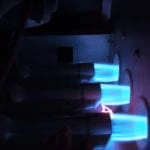What To Check When The Furnace Is Not Heating?
If your thermostat seems to refuse to get your home warm enough and your furnace is not providing the levels of heat that you need to stay comfortable, you probably need to have a professional HVAC technician troubleshoot what is going on. Before you call for professional furnace troubleshooting and furnace repairs, though, you should check a few things yourself to make sure that it’s not a minor DIY furnace problem that you can take care of yourself and not have to spend money on the service call for your HVAC system. We’ve outlined a few of those minor issues below:

- The Thermostat: A “malfunctioning” climate control system ends up being because of an improperly set thermostat far more often than you would think. If you live with other people, maybe one of them changed the thermostat and didn’t tell you. Or, maybe the thermostat needs to have its batteries replaced. Regardless, it’s a good idea to check it before you call a professional. If everything seems to be displaying correctly with the thermostat, but the problem persists, it might be something else in the air conditioner HVAC system. Cold air is not a good thing when it’s cold because the furnace stops working!
- The Air Filter: The air filter is the part of the furnace responsible for protecting the system from dust and other debris commonly found in a home’s ducts. While the filter does a very good job of protecting the furnace from these contaminants, it has no way of ridding itself of the contaminants that it collects. If the filter isn’t changed every so often, it will eventually become clogged due to the buildup of debris. This blocks the airflow into the furnace, blocking air from the heat exchanger, and can possibly cause overheating, as well potentially preventing it from circulating hot air throughout the house. Dirty air filters are among the most common problems when you’re not getting warm air from heating & cooling systems. You should check your air filter at least once every three months or so during your furnace maintenance, and replace it as necessary to keep the air flowing.
- The Pilot Light: Most modern combustion heating systems don’t make use of standing pilot lights anymore. That is, there isn’t a small gas flame that’s always burning so that it can light the burner assembly at a moment’s notice. Plenty of natural gas HVAC systems still do use those lights, though, and if your furnace has a standing pilot light it’s a good idea to check it if the system won’t heat. If the pilot light is out, try relighting it and seeing if that fixes the problem. If the pilot light won’t stay lit, or the furnace ignites, you may have a thermocouple problem. The thermocouple is a safety device that controls the gas supply to the HVAC system, in conjunction with the gas valve and other gas line items. If the pilot light appears to be fine, then the problem is probably located elsewhere. If the pilot light won’t light, or won’t stay lit for more than a short time, then you’ve probably found the problem. You’ll need an HVAC professional to fix it, though.
- The Circuit Breaker: If your furnace isn’t turning on at all, it might be because of your circuit breaker. Check the panel to see if any circuits are tripped. If resetting the circuit breaker fixes the problem, then you’re all set with this easy fix! If not, you’re going to need to find a professional technician to take a look at the system for you. Things like the electronic ignition, flame sensor, power switch and more all need some juice to run – so make sure to check your circuit breakers before calling!
- Airflow And Ductwork: Sometimes your HVAC system is correctly sized, and your blower motor is sending the heated air into the ductwork, but you’re just not getting enough heat through the air conditioning vents in the home. This can be an airflow issue caused by having diverters and baffles not set correctly (this is also a situation where the room temperature in one room in your home may be much cooler or warmer than the others). When homeowners encounter this issue, they may have tried several other DIY repairs first, such as inspecting the furnace filter and replacing it if it is a clogged filter, making sure a limit switch hasn’t been tripped, circuit breakers, pilot lights for gas furnaces, and so on. Ensuring your air ducts are properly flowing can sometimes be an easy fix instead of calling for professional HVAC repair.
Climate Control Heating and Cooling, Inc. offers a full range of furnace repair services in Kansas City, MO. If you need help with your furnace, contact us today to schedule an appointment with one of our expert technicians about repairing your older furnace, replacing it with a new HVAC system or heat pump, or to get your currently good running system maintenance check. Call today and Comfort and care from the team with the bear!




